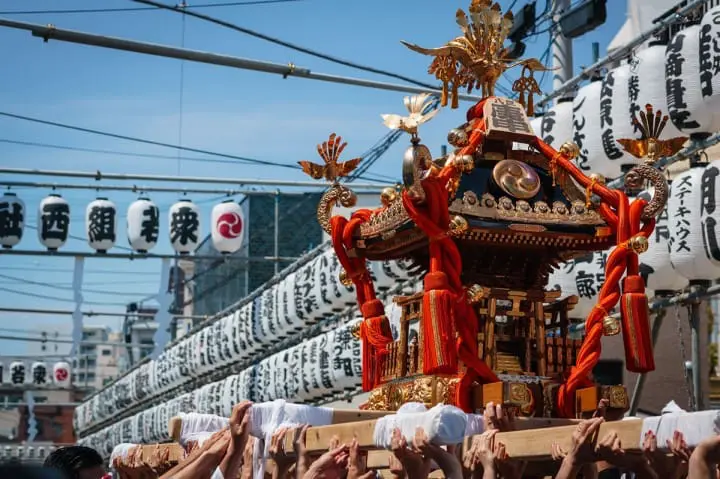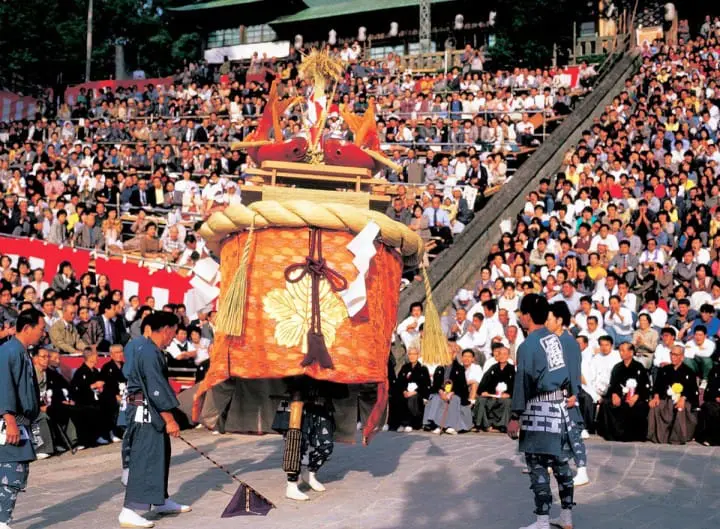Dashi And Yatai (Festival Floats) - Japanese Encyclopedia

Today we introduce dashi and yatai, floats that are seen at Japanese festivals. The names for these floats differ from region to region. We'll also explain the difference between a dashi and mikoshi, and feature festivals where you can see dashi.
What Exactly Are Dashi and Yatai?
Dashi and yatai are essentially colorfully decorated floats that appear in Japanese festivals, pulled and moved along the street by large groups of people.
In general, they are built to stand tall, and their height can range from just one meter all the way up to an impressive ten meters, in a wide variety of types and styles.
As shown below, dashi and yatai are called by different names depending on the festival and the region of the country.
Kasaboko - Saitama prefecture's Chichibu Festival.
Danjiri - A name used primarily in the Kansai region at festivals such as the Kishiwada Danjiri Matsuri in Osaka.
Yamahoko - Festivals such as the Gion Matsuri in Kyoto.
Yamakasa - Festivals such as Fukuoka's Hakata Gion Yamakasa.
Hikimono - Festivals such as Tokyo's Kanda Matsuri and Nagasaki's Nagasaki Kunchi.
In addition, dashi and yatai are sometimes referred to as hikiyama and at other times are simply called yama.
A Different Kind of Yatai
Many people associate the word 'yatai' with the food stalls found at festivals serving yakisoba, cotton candy, candied apples and so on.
However, in this article we are not referring to this definition of the word. Both words are spelled and pronounced the same, so it can sometimes be a little confusing and misleading since both make their appearance at Japanese festivals.
How Do Dashi and Mikoshi Differ From Each Other?
At Japanese festivals, mikoshi (portable shrine) are a common sight too. Mikoshi and dashi are usually differentiated in the following way:
・Dashi are pulled by people, mikoshi are carried on people's shoulders
・People can ride atop a dashi, but not allowed to ride on a mikoshi
These differences symbolize the unique origins of dashi and mikoshi.
Dashi: Its Origins and Characteristics

©︎JNTO
Dashi were originally made to resemble mountains. This was a reflection of minkan shinko (*1), or folk religion, in which it was believed at the time that spirits lived in the mountains. These divine spirits descended from the heavens as yorishiro (*2), to occupy trees on a mountain peak, or rocks and other objects in nature.
It is believed that dashi are built for the gods, for when they descend to the earth to serve as yorishiro. The spears and swords adorning the tops of dashi are said to serve as markers for these divine spirits. People ride atop the dashi in order to help welcome the gods.
*1 Minkanshinko: Japanese folk religion in which various beliefs are worshiped by its followers depending on the particular region of the country.
*2 Yorishiro: an object, animal or area that's occupied by a divine spirit.
Mikoshi: Its Origins and Characteristics

On the other hand, mikoshi mainly make their appearance at shinto festivals. Gods which are honored at the shrines, those which mainly protect and look after characters appearing in Japanese mythology, and those people who were born on that land, called ujigami, or local deities, are able to travel via mikoshi. So in a sense, the mikoshi make the rounds from shrine to shrine picking up the various gods.
It's believed that the gods drive away impurity and deliver good fortune, as they make their procession around town on the mikoshi. The mikoshi is considered to be sacred, so people are not allowed to ride on it.
5 Japanese Festivals (Matsuri) Where You Can See Dashi!
Takayama Matsuri in Gifu Prefecture (April, October)

© JNTO
During the lively and bustling Takayama Matsuri, a total of ten dashi weave their way through the city, during the day and also in the evening. Also you don't want to miss the long procession of people (goshinko) who are dressed up in Edo period costumes.
For more details please look at the following article: The Gorgeous Takayama Festival: Highlights And Schedule In 2017.
Kanda Matsuri in Tokyo (May)

© Tokyo Convention and Visitors Bureau
The Kanda Matsuri is held at Kanda Myojin Shrine in Tokyo. Many unique hikimono (festival floats) make their appearance, including those decorated with demon heads and large catfish.
To learn more, please take a look at: Visiting Japan In May? Enjoy The Kanda Festival In Tokyo!
Hakata Gion Yamakasa in Fukuoka (July)

©︎JNTO
Hakata Gion Yamakasa is held at Kushida Jinja Shrine in Fukuoka city's Hakata area. Included in the many yamakasa (festival floats), are ones elaborately decorated with fish, and samurai, made from bamboo and washi (Japanese paper), riding atop waves. One characteristic of this festival, is that cheering onlookers splash water on the float members to offer them good luck and also to help keep them cool under the summer sun, as the yamakasa is making its way down the street.
Please see Fukuoka: Hakata Heats Up With Hakata Gion Yamakasa Festival 2017 for more details.
Gion Matsuri in Kyoto (July)
The most famous festival among those in which dashi make an appearance, is the Gion Matsuri. The main attraction of the festival is a float called naginatahoko, which is adorned on top with a long katana, or sword. Inside the top part of the dashi, a young child referred to as chigo (yorishiro divine spirit), rides the float. This is a festival dating back more than one thousand years, and its various rules and customs are preserved and honored, even today.
Take a look at Gion Matsuri, Kyoto- Enjoy The Floats And Rhythm Of A Great Festival to learn more about this festival.
Nagasaki Kunchi (October)


Photo courtesy of: Nagasaki Prefecture Tourism Federation
Nagasaki Kunchi, which is held in Kyushu's Nagasaki city, has drawn its influences from Holland, Portugal and China. There are various hikimono (festival floats), including those resembling ships, and ones adorned with a large decoration called a kasaboko.
For further details please refer to this article, The Exotic Nagasaki Kunchi Festival 2017: Event Schedule And Highlights.






































![[2026] Top 5 Strawberry Picking Spots in Tokushima, Naruto| Farms and Access Guide for January to May](https://resources.matcha-jp.com/resize/720x2000/2025/03/06-227165.webp)



